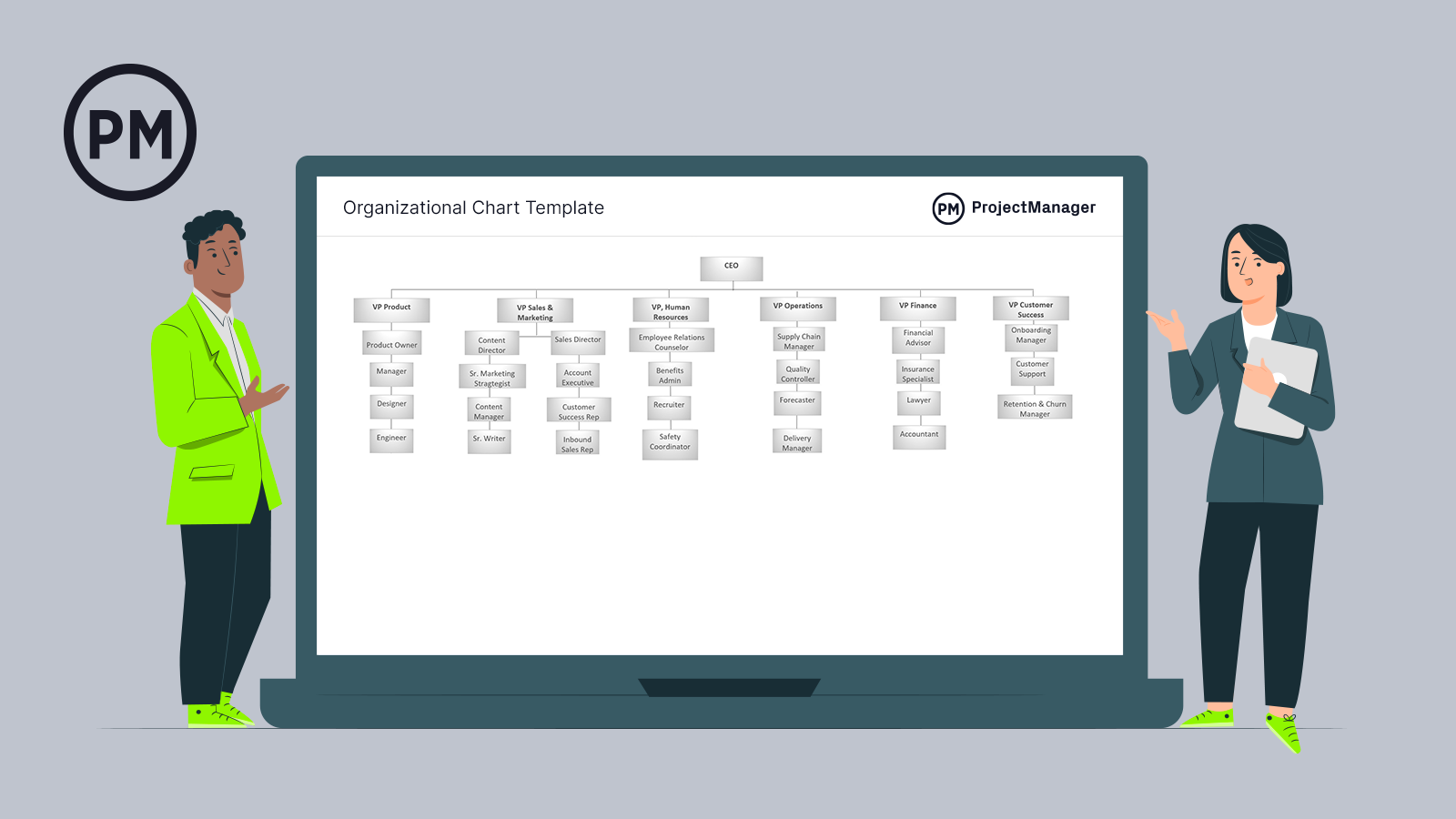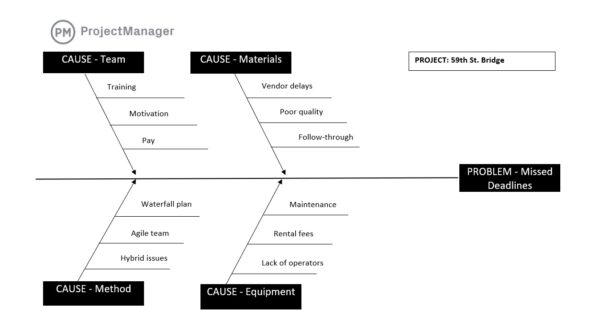Conflict is part of any work environment. That conflict exists isn’t the issue, but having an effective conflict resolution strategy to resolve that conflict if it begins to impact the business is crucial for any manager. While conflict can be a creative fuel that helps teams compete and work more productively, without proper conflict management, it can easily blow up and bring everything to a dead stop.
Conflict resolution is best faced by facts, not emotions. If you’re dealing with a team member who’s upset about something that happened in the project, listen to their complaints and either back them up or show them the error of their ways with data. ProjectManager is award-winning project management software that can generate reports that detail everything from overall status to workload, timesheets and more. Reports deliver live data that can be filtered to focus on what you want and easily shared to provide a fact-based path through conflict and resolution. Get started with ProjectManager today for free.

Now, let’s go over the different conflict management styles and conflict resolution strategies you can try in your organization.
What Is Conflict Resolution?
Conflict resolution can be simply defined as the process that organizations and teams follow to resolve disputes or conflicts of interest that might arise between team members. Team leaders are usually in charge of conducting this process and finding the best course of action, which finds a middle ground for both parties.
The 5 Conflict Management Styles
Most HR and business professionals use the five conflict management styles suggested in the Thomas-Kilmann conflict resolution model. These help them better understand how to manage different types of conflict situations. These five conflict management styles have different levels of assertiveness and cooperativeness. In the Thomas-Kilmann conflict resolution model, assertiveness is defined as the extent to which you try to satisfy your own interests and cooperativeness is the extent to which you try to satisfy others’ concerns.
Accommodating
Accommodating conflict it’s the most cooperative approach which involves giving up on your concerns and satisfying the other party to avoid conflict. This can be a good approach when you’re facing low-priority conflicts in the workplace.
Avoiding
This conflict resolution style is self-explanatory; it consists of avoiding any conflict. While it might sound too passive, avoiding conflict can be the best choice in certain workplace situations.
Collaborating
This conflict style consists of seeing your concerns and those of the other party as equal. This means that, when resolving conflict, you’ll analyze each other’s interests to find a win-win solution. It’s a more cooperative approach than a compromising conflict resolution, which is more assertive, even though it also finds common ground.
Competing
There are cases in the workplace where the best alternative to resolve conflict is to constructively oppose the other party. This conflict management style is highly assertive and best suited for individuals with project leadership roles, as they have the authority to decide which is the best course of action.
Compromising
This style is the perfect balance between assertiveness and cooperativeness. It consists of finding a middle ground, which is seen as a solution that’s accepted by both parties but isn’t completely satisfactory for either of them. This style is often used when there’s a strong conflict that needs to be resolved and this middle ground is the only viable choice.
To apply these conflict management styles, managers and business leaders need to develop certain skills to support their teams.

Get your free
Organizational Chart Template
Use this free Organizational Chart Template for Excel to manage your projects better.
Conflict Resolution Skills
To resolve conflict, you should build the following skills:
- Emotional intelligence: As a conflict mediator, you must remain calm at all times and help others deal with their emotions.
- Leadership skills: A good leader understands how to motivate his team and build a collaborative atmosphere.
- Communication skills: Effective communication with your team helps prevent conflict and facilitates the conflict resolution process.
- Interpersonal skills: As a team leader, you need to be aware of how you interact with others and set an example.
- Project planning: The better you plan your projects, the easier it’ll be for everybody on the team to understand their role, which reduces the chances of a conflict.
- Resource management: Effective resource allocation helps everybody do their job. Underallocation leads to burnout and other issues that might cause conflicts in your team.
Conflict Resolution Process
There’s not a single conflict resolution process that works for all organizations or teams. However, most organizations follow a similar process. Here are six simple conflict resolution steps you can follow as a mediator when solving a conflict:
Identify the Root Cause of the Conflict
Before anything, it’s important to understand what the conflict is and then find the main causes of the problem. When dealing with conflicts among team members, it’s important to hear what the parties have to say about the incident. You can use root cause analysis techniques for more complex conflicts that involve lots of causes and contributing factors.

Identify the Concerns of Both Parties
Once you’ve understood the overall nature of the conflict and its main causes, you’ll need to understand what the opposing parties want from this conflict resolution process, which will consist of finding a solution that’s accepted by both.
Identify Conflict Resolution Barriers
Before finding a solution, take time to identify the barriers that might slow down the conflict resolution process and try to eliminate them.
Choose a Conflict Resolution Style
Take into account the previous steps to choose the conflict resolution style that best fits your particular case. In some cases you might need to tell someone they’re wrong, find a partially satisfactory middle ground, or build a win-win solution that satisfies both parties. This analysis should be done on a case-by-case basis.
Find a Solution to the Problem
After implementing a conflict management style, you should have a viable solution that solves the conflict. Before implementing any solutions, make sure that the conflict participants agree on the solution and commit themselves to it.

Check If the Conflict Persists
The conflict resolution process shouldn’t finish once you solve the conflict by finding a solution. You must follow up with the team to make sure the conflict has been successfully resolved.
10 Conflict Resolution Strategies
Here are 10 practical conflict resolution strategies you can use to prevent, control and resolve conflicts.
1. Define Acceptable Behavior
Before there’s any hint of a conflict, you can reduce or even eliminate potential problems by setting a standard of behavior in the workplace. If you give the team the room to define what is and is not appropriate, they will.
However, as a manager, it’s your responsibility to set the tone. You can do this by writing specific job descriptions, creating a framework for how discussions are run, noting the hierarchy and who is responsible for what, defining proper business practices, choosing which project management tools to use, helping with team building and leadership development, etc. The more you set the guidelines, the better the team can follow them.
2. Don’t Ignore Conflict
Depending on the type of person and manager you are, there are several ways you might respond to conflict in the workspace. For one, you could ignore it and let the participants work it out among themselves. This isn’t always the worst approach. Teams must know how to collaborate, and conflict resolution is one of the tools they’ll need to do that.
However, if you’re avoiding dealing with conflict because it makes you uneasy or because you don’t want to reprimand someone, then that’s a misstep. Of course, it’s your job as a manager to deal with such matters. You have the authority and should act when it is called for. Not doing so only gives the conflict legs on which to carry itself to a confrontation that will have an even worse impact on business.
3. Choose a Neutral Location
One of the first steps to diffuse any conflict is to change the environment. People are heated and that anger is often tied to a place. It sounds odd, but removing the people from the room they’re fighting in will help put the conflict in perspective.
Then, to resolve the conflict, you’ll want to bring the upset individuals to a neutral location. A neutral space will first bring things down to a level in which a constructive conversation can occur. Secondly, by suggesting a meeting in a coffee house, or anywhere outside the office where there isn’t intrinsically a power dynamic, you’re more likely to create a comfortable atmosphere where you can productively deal with whatever caused the issue.
4. Start with a Compliment
After you’ve broken away from the place where the conflict arose, you can address the problem. But you don’t want to jump right into a conversation with an accusatory tone. Your job is to hear all sides and make an executive decision based on the facts and the needs of the work being done. Therefore, to get a person comfortable enough to talk, start by complimenting them. You want to show that there’s no bad guy or good guy here. You’re attacking the problem, not the person.
5. Don’t Jump to Conclusions
The reasons for any conflict are often more complex than they first appear. To be just in your treatment of all parties, it’s advised not to conclude anything at the offset. Even if you think the conflict is obvious, allow everyone to share their perspective. Get a sense of the history involved. You don’t want to assume anything about anyone. Gather your facts and then weigh in with the wisdom of a judge.
6. Think Opportunistically, Not Punitively
While some conflicts require consequences, most are just sparked by passionate people coming at a situation from different vantage points. The truth is that when conflicts arise, so does the opportunity to teach or learn. Being a manager is seeing these conflicts as a means to address what has previously hidden problems within the team dynamics.
7. Offer Guidance, Not Solutions
Another thing to think about as you address conflict in your workforce is not jumping to just righting the wrong. What that means is there could be an obvious reason for the conflict and a similarly clear way to get people back on the same page and working productively.
You’re leading the group, not taking sides in their arguments. It’s best if you can get the team to work together to resolve the conflict. That means taking more time to guide them to the conclusion you see, but they’re too emotionally involved to notice.
8. Provide Constructive Criticism
In any conflict, there’s a multitude of approaches, some more critical than others. But sometimes things are wrong, and criticism is the only valid way to deal with it. Be that as it may, the people you’re criticizing are the same people you’ll be working with tomorrow and next week and so forth. So, how do you criticize without embittering, so you can still effectively lead?
That’s where constructive criticism comes in. It’s an approach that allows you to address the issue and lay blame but also support the good work that was done. You offer guidance so that the problem can be fixed. The team now has the tools to avoid repeating it and no one is resentful.
9. Don’t Intimidate
As a manager, you’re in a position of authority. Don’t abuse it. It might seem like the simple fix to coerce the correct course, but that’s not thinking in the long term. The team never learns anything from this but to fear you, which means they won’t confide in you when something starts going wrong, leaving you in the dark until the issue is possibly beyond repair. So, take the time to work through your conflict resolution in such a way that it doesn’t pop up again the next day.
10. Act Decisively
Remember, you want to put the time into conflict resolution to do it right. But once you’ve gone through that process, then it’s time to act, and you should do so decisively.
Don’t let the decision wait and leave the team lingering. It sets a bad precedent in terms of your leadership. You’re leaving a void at the top, which will get filled by ideas other than your own, and you may lose the authority you need to lead. So, when you come to a decision, act on it. Some might not like it, but they’ll at least know where you stand.
How ProjectManager Can Help With Conflict Resolution
Conflicts arise in a project when people are working against each other. To keep everyone on the same page and working together, try ProjectManager, award-winning project management software that helps teams manage work online without conflict.
With ProjectManager, everyone knows exactly what they have to do to contribute. Managers can assign tasks, and team members can see all of their assigned tasks in one place. No more passing the buck or hiding behind lost emails. Here, work and roles are clearly defined.
Because ProjectManager helps teams collaborate better, it’s easy to provide feedback and create a sense of understanding and expectation. This helps prevent potential conflict. Team members can leave comments on tasks, attach files and stay in touch with one another. If someone needs to be brought into the conversation, simply tag them and they can provide feedback too. Teamwork has never been easier.

Finally, conflict can arise whenever something just doesn’t go as planned. Our project management software gives you the tools to plan, execute and track projects with ease. If you’re hitting your goals, there’s no need for conflict! A happy team is a successful team. See how ProjectManager can help your team today.
If you’re feeling conflicted about what is the right project management tool for you and your team, then ProjectManager has the resolution. Our online software has a real-time dashboard to help you keep an accurate eye on progress and online Gantt charts to make scheduling transparent, keeping everyone aware of what tasks are theirs and when they’re due. See how it can remove conflict from your work life by taking this free 30-day trial today!


